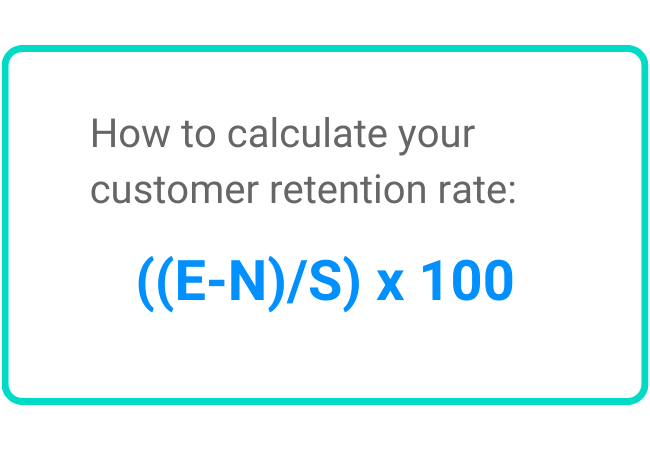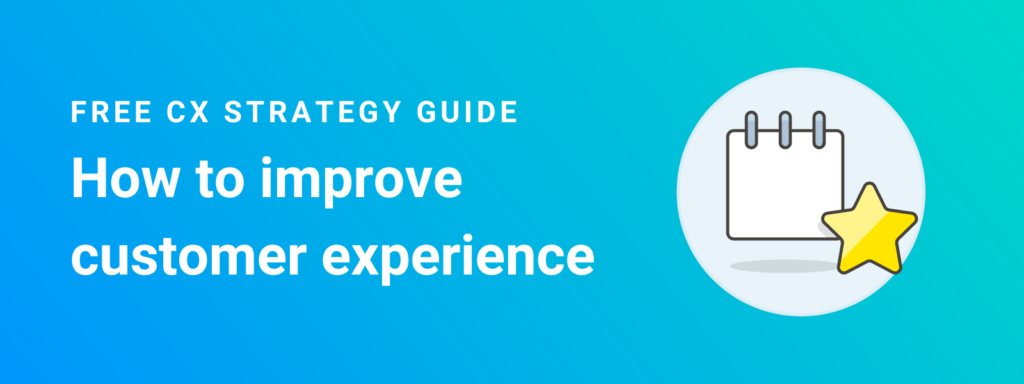Did you know it costs up to five times more to acquire new customers than to keep the ones you already have?
The business case for focusing on customer retention can’t be understated. Research by Forbes found companies have a 70% chance of selling to current customers versus only a 20% chance of selling to new customers.
But what exactly is customer retention, and what strategies can your business take to increase your retention rate? In this blog post, we go over what customer retention is, how to calculate your retention rate and examples of customer retention strategies used by actual companies.
What is customer retention?
Customer retention is a measure of how successfully your business can keep customers after you acquire them. It’s a valuable metric for assessing customer loyalty and the health of your business.
You can calculate your customer retention rate by subtracting the number of new customers (N) from the total number of customers in a given timeframe (E). Then, divide that number by the number of customers you had at the start (S). Afterward, take that number and multiply it by 100.

For example, if you had 250 customers at the end of the first quarter, 150 new customers you’ve acquired and 175 at the start of the quarter, you’d have a customer retention rate of 57%.
What is a good customer retention rate?
While a customer retention rate of 100% would be ideal, it’s not a practical goal for your business. So, what’s a good customer retention rate?
The average customer retention rate across business sectors is 75%. However, it can vary widely depending on the industry. In telecommunications, the average retention rate is 78%. However, for internet service providers, the average is 81%.
Customer retention challenges for telecom and broadband
Retaining customers is a constant challenge for any business, but especially broadband and telecom companies. So, what’s causing customers to leave? Below are some of the current customer retention challenges facing the telecom and broadband industries.
Rising customer expectations
The demand for fast and reliable telecom and broadband services is higher than ever. These are called lifestyle services, meaning customers rely heavily on them both at work and at home. Additionally, the number of remote workers tripled since the pandemic, further fueling the demand for high-speed broadband and telecom services.
Poor customer service
According to Forbes, 96% of customers leave after one bad service experience. Many businesses lose customers because of all-too-common customer service mistakes. Below are a few examples of poor customer service:
- The inability to speak to a human
- Lengthy contact center wait times
- Slow service or no response to support inquiries
- Multiple transfers between agents
To reduce customer churn, ensure your customers have a way to speak with a human agent. Companies should also focus on providing customer self-service options and omnichannel support.
Intense competition
The competition in the broadband and telecom sectors is fierce. This makes it hard for businesses to stand out and easier than ever for customers to switch to a different provider.
This is why providing excellent customer service is key to retaining customers. Research shows that customers are four times more likely to switch to your competitor if they experience poor customer service. Businesses that want to stand out from industry competitors and improve customer retention should focus on ensuring they deliver an exceptional service experience.
Examples of customer retention strategies that work
Given the fierce industry competition and ease of switching service providers, how do you ensure customers stick around? Below are a few strategies used to improve customer satisfaction and examples of customer retention by real companies that put them into practice.
Provide omnichannel customer support
Omnichannel support means providing multiple options for customers to receive customer service. Not all of your customers want to call into your contact center. Additionally, if all your customers have to call to receive support, it can create long service queues and increase business expenses.
Omnichannel support allows customers to receive the support they need when and how they want it. This might mean using chatbots, live chat, email or SMS channels. Whatever the customer chooses, companies should ensure a consistent support experience across all channels and devices.
Omnichannel support strategy example: TELUS
TELUS is one of Canada’s largest telecom providers, supporting over eight million customers. With so many customers depending on its services, TELUS wanted to optimize the customer journey with frictionless support.
TELUS knew its customers needed options beyond calling into its contact center. It implemented an omnichannel service solution that allowed customers to access support via chat, web or its self-help mobile app.
As a result, TELUS saw an immediate 10% reduction in call volume and averaged around 750,000 resolutions annually. With omnichannel support, customers can access reliable, updated support regardless of their communication preferences.
Improve agent training
Agents who lack the right tools and training can have lower agent confidence, leading to multiple transfers between departments or forcing customers to call numerous times because a service issue is unresolved.
A good first step to improve agent training is ensuring you design an effective agent onboarding program. Onboarding can make or break the success of your contact center. A strong onboarding program significantly reduces turnover and improves agent confidence in handling service inquiries.
Consider using tools like virtualization or virtualized tech support in your agent training program. Virtual devices mimic the same functionality as physical devices. However, unlike physical devices, agents can switch between multiple versions of that device. This allows for faster agent onboarding and leads to increased first-call resolution rates.
Improve agent training example: Twigby
Twigby, a Tennessee-based telecom provider, wanted to improve its contact center performance. It had a large influx of new agents but didn’t have a robust knowledge base for its latest hires. As a result, new agents relied on experienced agents for assistance, making it difficult to keep up with the volume of service requests.
That all changed when Twigby focused on finding a solution that featured virtual devices, software, and app emulators. Agents could quickly access the information they needed to guide customers through resolving their tech issues.
As a result, Twigby saw an 11% improvement in agent net promoter score (NPS) ratings. It also experienced a 15% increase in positive customer ratings, with an average of 4.5/5 stars on Google. Here’s what one Twigby customer had to say:
Provide customer self-service options
Did you know that eight out of 10 customers prefer to resolve tech issues independently before reaching out to your contact center? Customer self-service is no longer a nice-to-have but a must-have for retaining customers.
However, self-service is no longer just a text-based FAQ page. Companies wanting to stand out from the competition would benefit from using interactive tutorials or how-to video formats.
Customer self-service is a win-win for your business and your customers. When done right, it lowers call volume at your contact centers by empowering customers to resolve their tech support issues independently. This helps your company reduce business expenses and improves your net promoter score (NPS).
Customer self-service example: Verizon
As the recipient of over 30 JD Power Awards, Verizon Wireless needs no introduction. With over 145 million subscribers, Verizon was looking for intelligent self-serve options to provide access to easy and fast support for its customers.
Verizon implemented interactive self-service tutorials to guide its customers step by step through troubleshooting their own devices. Customers adopted these tutorials within just a few months, and as a result, the network’s call deflection rate skyrocketed to 85%.
This helped drive significant cost savings for Verizon. The network saves over one million dollars per contact center annually. Additionally, the convenience and ease of these interactive tutorials have greatly improved the tech support experience for customers. Here’s what Tom’s Guide had to say about Verizon’s customer self-service:
Ozmo’s interactive tutorial continues to be one of my favorite features, because it delivers an easy-to-understand, step-by-step visual representation of the function you want to access
Tom’s Guide, “The Best (and Worst) Phone Carrier Customer Support
Develop a customer retention strategy that works for your business
Now that you’ve seen some examples of customer retention strategies, what steps will you take to improve customer loyalty?
While there isn’t one magic strategy that works for all businesses, a lot of successful examples of customer retention strategies boil down to one thing: customer service. Consider what steps you can take to develop a customer service experience that ensures customers don’t want to leave.
Are you looking for an easy-to-implement tool that aids customer retention and effectively scales support? As a leader in omnichannel support, Ozmo is trusted by Google Fi, Appalachian Wireless, TELUS and more. Learn more about the future of tech support today!





